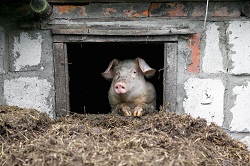Reusable construction technology reduces CO2 and waste
As cited in a recent OECD report, steel and cement, two of the commonest construction materials, combined are responsible for (approximately) 15 % of ‘global energy system combustion and industrial process carbon dioxide emissions’(opens in new window). Reducing the amount of steel and concrete could contribute significantly to cutting CO2 emissions. Additionally, demolition waste often ends up in landfill, adding to pollution. The REUSE(opens in new window) project, supported by the Marie Skłodowska-Curie Actions programme(opens in new window) has developed two novel shear connectors to be used in demountable steel-concrete composite buildings. “This solves the problem of demolition, as the building’s components can be easily disassembled and reused. This is better than recycling, which still produces CO2,” says research supervisor George Vasdravellis.
Two connector designs
Construction practices typically make the disassembly and reuse of structural components almost impossible. While buildings are usually designed for a lifespan of 40-50 years, retrofitting or upgrading a building may be necessary much earlier. There is also the matter of temporary buildings, for example for one-off events such as the Olympic Games. These are often redundant after the event and so simply demolished, resulting in more waste. Composite buildings are comprised of steel sections and precast concrete slabs. These are connected by shear connectors, so-called because they can withstand shear forces, making the resulting composite beams significantly stronger than they would be without connectors. But traditional shear connectors are welded onto steel and embedded in concrete, making them impossible to separate and so reuse. REUSE’s demountable shear connectors allow the slabs and steel sections to be easily separated for reuse in new projects. The design of the build components means they can also be easily fabricated off-site and then quickly installed on-site. Ultimately the project designed two types of connectors: one bolted and the other a bolted-welded hybrid, both still demountable. Laboratory tests assessed the behaviour of the connectors for their structural properties and responses to stresses. Next, computer models were calibrated against these test results, before simulating a range of likely scenarios to test the connectors for reliability. Finally, the team performed mechanical ‘push-out tests’(opens in new window). These check the strength and resilience of the composite materials, to ensure compliance with European standards, especially Eurocode 4(opens in new window). “Our testing demonstrated that our two demountable shear connectors can be designed with advantageous structural properties for steel-concrete composite buildings or bridges,” adds Vasdravellis.
Benefitting the environment and human health
Using demountable and reusable structures in the construction industry, such as that of REUSE’s, will reduce CO2 emissions and landfill waste due to unnecessary demolition, benefiting both the environment and human health. More broadly, the adoption of ‘design for reuse’ concepts in construction will contribute to the ambitious environmental targets set by the EU(opens in new window). “Our designs are novel and tick all the right boxes in terms of practicality, structural performance and sustainable features,” notes Vasdravellis. To bring the technology close to commercialisation, the team will further test their designs on full-scale girders or beams. This will enable more advanced assessments of factors such as fatigue performance under repeated loading, relevant to bridges, and cyclic loading performance, relevant to earthquake-prone regions. Additionally, more life-cycle analysis of structures using the proposed technology will be needed to accelerate development of the necessary policies and procedures relevant to reusable/demountable structures.







